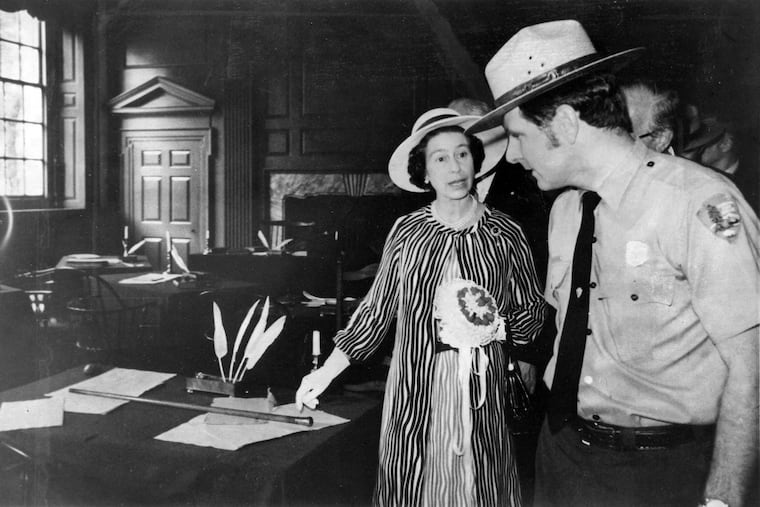My day with the queen: Behind the scenes of her 1976 Philly visit
Hobie Cawood was in charge of Independence National Historical Park the day the Queen of England arrived for a visit — 200 years after some unpleasantness had occurred in the area.

Maybe the high point of Queen Elizabeth’s visit to Philadelphia on July 6, 1976, was the presentation of the Bicentennial Bell — a replica of the Liberty Bell forged at White Chapel Foundry, where the original was cast more than two centuries before.
Or maybe the high point was the arrival of the royal yacht Britannia at Penn’s Landing on that hot, bright morning. Or maybe it was the formal dinner for the queen hosted by the city at the Philadelphia Museum of Art. Mayor Frank Rizzo was there, seated next to the queen, and seemed to enjoy it, although he was spotted getting up and walking around the hall several times.
Hobart G. Cawood, then-superintendent of Independence Park, remembers it all vividly. Now long retired and living in North Carolina, the 87-year-old Cawood escorted the queen during a large part of her visit, which included a tour of Independence Park and, later in the day, a presentation of the Bicentennial Bell at the old park visitors’ center at Third and Chestnut Streets.
» READ MORE: Queen Elizabeth II was the first sitting monarch to visit Philly. Here’s what happened when she did.
But for Cawood, universally known as Hobie, the day’s most memorable moment may have involved the queen’s purse.
In a telephone interview Thursday, Cawood recalled that the queen, Prince Philip, and the royal entourage of several dozen flew to Bermuda and picked up the Britannia there, sailing it from there to the Delaware River and Penn’s Landing.
Philadelphia was the first stop on the queen’s American visit.
There were thousands of people all around, but the queen seemed perfectly at ease, Cawood said, a monarch used to fuss, and perhaps expecting it.
Cawood recalls chatting with Secretary of the Interior Thomas S. Kleppe and his wife, Glen, who looked at the queen and said, “I wonder what she has in her purse”
This was more of a mystery than might at first be imagined, said Cawood. The queen was never seen without her purse.
“You know she’s got ladies in waiting,” he recalled. “If she needs a dime or if she needs a Kleenex or something, all she’s got to do is turn and look at somebody and they’ll give it to her, but she carries the purse with her all the time.”
Cawood shook his head. He looked at Glen Kleppe. “I have no idea,” he said.
After the queen finished her remarks and answered some questions, “she got back in the car and went to call on the mayor, Mayor Rizzo,” said Cawood. “And then the secretary [of the Interior] and the mayor, the governor [Milton J. Shapp], and some folks had lunch with her on board the Britannia.”
Cawood remained behind, giving some last-minute instructions for the Bicentennial Bell presentation ceremony to his staff.
Kleppe and other officials returned from Penn’s Landing moments before the bell was to be presented in a dignified ceremony “from the people of Great Britain to the people of the United States.”
The crowd had gathered.
Secretary Kleppe pulled Cawood over to the side.
“He says, ‘Hobie, Hobie, guess what — I know what’s in the purse.’ And I said, ‘What?’ And he said, ‘Well, when we went into lunch as the president’s representative, I sat on her left. And we were all gathered at the table and when she was seated, she opened up her purse and took out a C-clamp and screwed it into the table and closed her purse and hung her purse over the C-clamp. And when lunch was over, she picked up her purse, unscrewed the clamp, put the clamp back in the purse, and was ready to go.’”
» READ MORE: Queen Elizabeth’s death deprives Britain and the world of a rock of stability | Trudy Rubin
Queens apparently are never without their C-clamps.
At one point, Cawood and the queen visited the portrait gallery inside the Second Bank of the United States on Chestnut Street, a block east of the visitors’ center where the Bicentennial Bell was hung.
They mounted the steps to the building entrance, he recalled.
“We came up on those steps, and looking east and west on Chestnut Street, almost as far as you could see, were people,” Cawood said. “They all had handkerchiefs in their hands, and they were waving them and it reminded me of some of the things you saw in World War II. But she was very touched by that. And said so at the time.”
The queen “paused for a minute and waved” out to the people on the street, Cawood remembered. And then, just before entering the portrait gallery, she stopped.
“The Friends of Independence had a little ice cream and refreshment stand there that we opened every summer for visitors,” Cawood said. “She stopped and talked to the waitress there, I mean to the lady behind the counter. So she was very comfortable, very easy. And very pleasant.”
That evening, Cawood and his wife attended the dinner at the Art Museum. He was dressed in formal dinner attire.
“My wife and I were talking to someone else and someone took my elbow and I turned around and it was the queen,” said Cawood, still a little surprised. “She says, ‘My, my you look quite different tonight.’ I had on a tuxedo or instead of my national service uniform. She had this tiara and this beautiful peach dress. And I said, ‘Your majesty you sure look good!’ And then I introduced her to my wife. That was a big thrill for her.
“What a day.”